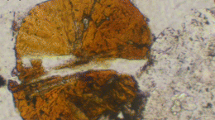Abstract
Phosphoinnelite, an analogue of innelite with P > S, has been found in a peralkaline pegmatite vein crosscutting calcite carbonatite at the phlogopite deposit, Kovdor pluton, Kola Peninsula. Cancrinite (partly replaced with thomsonite-Ca), orthoclase, aegirine-augite, pectolite, magnesioarfvedsonite, golyshevite, and fluorapatite are associated minerals. Phosphoinnelite occurs as lath-shaped crystals up to 0.2 × 1 × 6 mm in size, which are combined typically in bunch-, sheaf-, and rosettelike segregations. The color is yellow-brown, with vitreous luster on crystal faces and greasy luster on broken surfaces. The mineral is transparent. The streak is pale yellowish. Phosphoinnelite is brittle, with perfect cleavage parallel to the {010} and good cleavage parallel to the {100}; the fracture is stepped. The Mohs hardness is 4.5 to 5. Density is 3.82 g/cm3 (meas.) and 3.92 g/cm3 (calc.). Phosphoinnelite is biaxial (+), α = 1.730, β = 1.745, and γ = 1.764, 2V (meas.) is close to 90°. Optical orientation is Z^c ∼ 5°. Chemical composition determined by electron microprobe is as follows (wt %): 6.06 Na2O, 0.04 K2O, 0.15 CaO, 0.99 SrO, 41.60 BaO, 0.64 MgO, 1.07 MnO, 1.55 Fe2O3, 0.27 Al2O3, 17.83 SiO2, 16.88 TiO2, 0.74 Nb2O5, 5.93 P2O5, 5.29 SO3, 0.14 F, −O=F2 = −0.06, total is 99.12. The empirical formula calculated on the basis of (Si,Al)4O14 is (Ba3.59Sr0.13K0.01)Σ3.73(Na2.59Mg0.21Ca0.04)Σ3.04(Ti2.80Fe 3+0.26 Nb0.07)Σ3.13[(Si3.93Al0.07)Σ4O14(P1.11S0.87)Σ1.98O7.96](O2.975F0.10)Σ3.075. The simplified formula is Ba4Na3Ti3Si4O14(PO4,SO4)2(O,F)3. The mineral is triclinic, space group P \(\overline 1 \) or P1. The unit cell dimensions are a = 5.38, b = 7.10, c = 14.76 Å; α = 99.00°, β = 94.94°, γ = 90.14°; and V = 555 Å3, Z = 1. The strongest lines of the X-ray powder pattern [d, Å in (I)(hkl)] are: 14.5(100)(001), 3.455(40)(103), 3.382(35)(0\(\overline 2 \)2), 2.921(35)(005), 2.810(40)(1\(\overline 1 \)4), 2.683(90)(200, \(\overline 2 \)01), 2.133(80)(\(\overline 2 \) \(\overline 2 \)2), 2.059(40)(204, 1\(\overline 3 \)3, 221), 1.772(30)(0\(\overline 4 \)1, 1\(\overline 2 \)7, 2\(\overline 3 \)2, 2\(\overline 3 \)3). The infrared spectrum is demonstrated. An admixture of P substituting S has been detected in the innelite samples from the Inagli pluton (South Yakutia, Russia). An innelite-phosphoinnelite series with a variable S/P ratio has been discovered. The type material of phosphoinnelite has been deposited at the Fersman Mineralogical Museum, Russian Academy of Sciences, Moscow.
Similar content being viewed by others
References
A. N. Chernov, V. V. Ilyukhin, B. A. Maksimov, and N. V. Belov, “Crystalline Structure of Innelite Na2Ba3(Ba,K,Mn)(Ca,Na)Ti(TiO2)2[Si2O7]2(SO4)2,” Kristallografiya 16, 87–92 (1971).
N. V. Chukanov, I. V. Pekov, and M. M. Moiseev, “Alkaline ‘Cross Pegmatites’ in the Kovdor Massif, Kola Peninsula,” in Proceedings of the Annual Session of the Moscow Division, All-Russia Mineralogical Society (Moscow, 2003), pp. 131–132 [in Russian].
N. V. Chukanov, M. M. Moiseev, I. V. Pekov, et al., “Nabalamprophyllite Ba(Na,Ba){Na3Ti[Ti2O2Si4O14](OH,F)2{: A New Titanium Phyllosilicate of the Lamprophyllite Group from Inagli and Kovdor Alkaline Ultramafic Massifs, Russia,” Zap. Vseross. Mineral. O-va 133(1), 59–72 (2004).
N. V. Chukanov, M. M. Moiseev, R. K. Rastsvetaeva, et al., “Golyshevite (Na,Ca)10Ca9Fe2Zr3NbSi25O72(CO3)(OH)3 · H2O and Mogovidite Na9(Ca,Na)6Ca6Fe2Zr3□Si25O72(CO3)(OH,H2O)4: New Mineral Species of the Eudialyte Group from Agpaitic Pegmatites of the Kovdor Massif, Kola Peninsula,” Zap. Vseross. Mineral. O-va 134(6), 36–47 (2005).
A. F. Efimov, S. M. Kravchenko, and E. V. Vlasova, “On the Mineralogy of Alkaline Pegmatites in the Inagli Massif,” Tr. IMGRE, No. 16, 141–175 (1963).
G. Ferraris, G. Ivaldi, D. Yu. Pushcharovsky, et al., “The Crystal Structure of Delindeite, Ba2{(Na,K,□)3(Ti,Fe)[Ti2(O, OH)4Si4O14](H2O,OH,O)2{, a Member of the Meroplesiotype Bafertisite Series,” Can. Mineral. 39, 1306–1316 (2001).
F. Hirowatari and K. Isono, “Yoshimuraite from the Manganese Ore Deposits of Taguchi Mine, Aichi Pref., Japan,” J. Mineral. Soc. Japan, No. 6, 230–243 (1966).
G. Yu. Ivanyuk, V. N. Yakovenchuk, and Ya. A. Pakhomovsky, “Kovdor,” in Minerals of Lapland (Apatity, 2002) [in Russian].
O. Johnsen, G. Ferraris, R. A. Gault, et al., “The Nomenclature of Eudialyte-Group Minerals,” Can. Mineral. 41, 785–794 (2003).
S. M. Kravchenko, E. V. Vlasova, M. E. Kazakova, et al., “Innelite: A New Barium Silicate,” Dokl. Akad. Nauk SSSR 141, 1198–1199 (1961).
A. A. Kukharenko, M. P. Orlova, A. G. Bulakh, et al., “The Caledonian Complex of Ultramafic Alkaline Rocks and Carbonatites in the Kola Peninsula and Northern Karelia,” in Geology, Petrography, Mineralogy, and Geochemistry (Nedra, Moscow, 1965) [in Russian].
A. M. McDonald, J. D. Grice, and G. Y. Chao, “The Crystal Structure of Yoshimuraite, a Layered Ba-Mn-Ti Silicophosphate, with Comments of Five-Coordinated Ti4+,” Can. Mineral. 38, 649–656 (2000).
I. V. Pekov, Doctoral Dissertation in Geology and Mineralogy (Moscow, 2005).
I. V. Pekov, I. A. Ekimenkova, N. V. Chukanov, et al., “Feklichevite, Na11Ca9(Fe3+, Fe2+)2Zr3Nb[Si25O73](OH,H2O,Cl,O)5: A New Eudialyte-Group Mineral Species from the Kovdor Massif, Kola Peninsula,” Zap. Vseross. Mineral. O-va 130(3), 55–65 (2001).
I. V. Pekov, A. G. Turchkova, E. V. Lovskaya, and N. V. Chukanov, Zeolites from Alkaline Massifs (Ekost, Moscow, 2004) [in Russian].
G. Raade and H.-J. Berg, “Powder X-Ray Diffraction Data for Innelite,” Powder Diffraction 15, 62–64 (2000).
O. M. Rimskaya-Korsakova and N. I. Krasnova, Geology of Mineral Deposits of the Kovdor Massif (St. Petersburg State Univ., St. Petersburg, 2002) [in Russian].
T. Watanabe, Y. Takeuchi, and J. Ito, “The Minerals of the Noda-Tamagawa Mine, Iwate Prefecture, Japan. III: Yoshimuraite, a New Barium-Titanium-Manganese-Silicate Mineral,” Mineral. J. (Japan), No. 3, 156–167 (1961).
K. Yvon, W. Jeitschko, and E. Parthe, “LAZY PULVERIX: A Computer Program for Calculating X-Ray and Neutron Diffraction Powder Patterns,” J. Appl. Crystallogr., No. 10, 73–74 (1977).
Author information
Authors and Affiliations
Corresponding author
Additional information
Original Russian Text © I.V. Pekov, N.V. Chukanov, I.M. Kulikova, D.I. Belakovsky, 2006, published in Zapiski Rossiiskogo Mineralogicheskogo Obshchestva, 2006, No. 3, pp. 52–60.
Considered and recommended by the Commission on New Minerals and Mineral Names, Russian Mineralogical Society, May 9, 2005. Approved by the Commission on New Minerals and Mineral Names, International Mineralogical Association, July 4, 2005 (proposal 2005-022).
Rights and permissions
About this article
Cite this article
Pekov, I.V., Chukanov, N.V., Kulikova, I.M. et al. Phosphoinnelite, Ba4Na3Ti3Si4O14(PO4,SO4)2(O,F)3, a new mineral species from peralkaline pegmatite of the Kovdor pluton, Kola Peninsula. Geol. Ore Deposits 49, 530–536 (2007). https://doi.org/10.1134/S1075701507070070
Received:
Issue Date:
DOI: https://doi.org/10.1134/S1075701507070070




